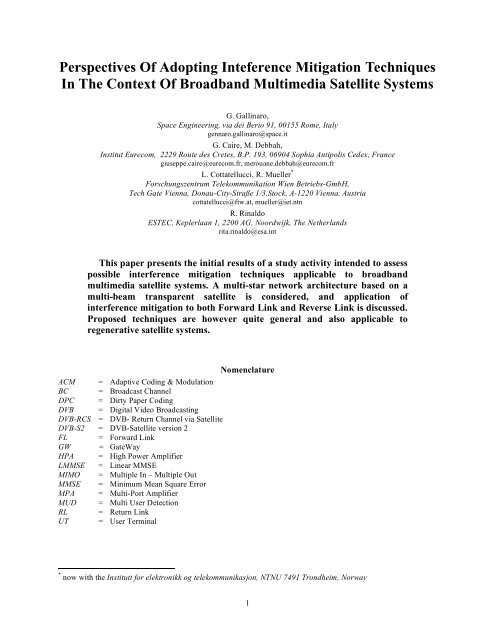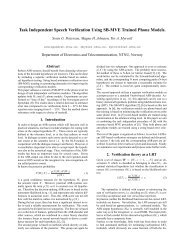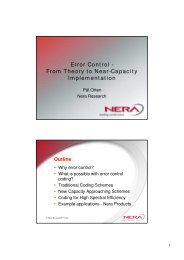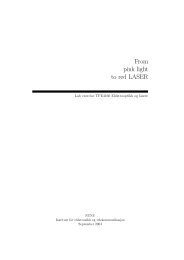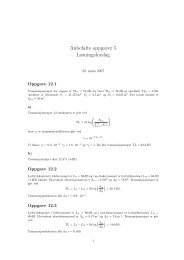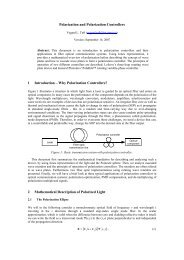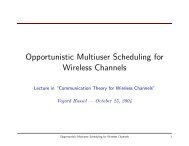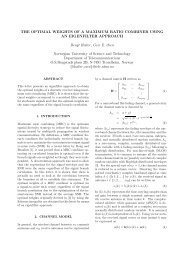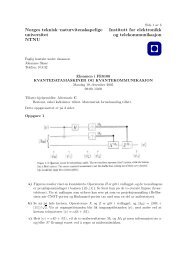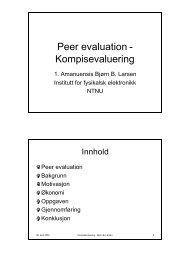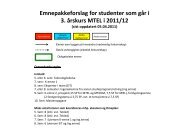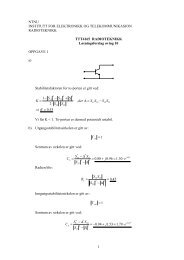Perspectives Of Adopting Inteference Mitigation Techniques In The ...
Perspectives Of Adopting Inteference Mitigation Techniques In The ...
Perspectives Of Adopting Inteference Mitigation Techniques In The ...
Create successful ePaper yourself
Turn your PDF publications into a flip-book with our unique Google optimized e-Paper software.
<strong>Perspectives</strong> <strong>Of</strong> <strong>Adopting</strong> <strong><strong>In</strong>teference</strong> <strong>Mitigation</strong> <strong>Techniques</strong><br />
<strong>In</strong> <strong>The</strong> Context <strong>Of</strong> Broadband Multimedia Satellite Systems<br />
G. Gallinaro,<br />
Space Engineering, via dei Berio 91, 00155 Rome, Italy<br />
gennaro.gallinaro@space.it<br />
G. Caire, M. Debbah,<br />
<strong>In</strong>stitut Eurecom, 2229 Route des Cretes, B.P. 193, 06904 Sophia Antipolis Cedex, France<br />
giuseppe.caire@eurecom.fr, merouane.debbah@eurecom.fr<br />
L. Cottatellucci, R. Mueller *<br />
Forschungszentrum Telekommunikation Wien Betriebs-GmbH,<br />
Tech Gate Vienna, Donau-City-Straße 1/3.Stock, A-1220 Vienna, Austria<br />
cottatellucci@ftw.at, mueller@iet.ntn<br />
R. Rinaldo<br />
ESTEC, Keplerlaan 1, 2200 AG, Noordwijk, <strong>The</strong> Netherlands<br />
rita.rinaldo@esa.int<br />
This paper presents the initial results of a study activity intended to assess<br />
possible interference mitigation techniques applicable to broadband<br />
multimedia satellite systems. A multi-star network architecture based on a<br />
multi-beam transparent satellite is considered, and application of<br />
interference mitigation to both Forward Link and Reverse Link is discussed.<br />
Proposed techniques are however quite general and also applicable to<br />
regenerative satellite systems.<br />
Nomenclature<br />
ACM = Adaptive Coding & Modulation<br />
BC = Broadcast Channel<br />
DPC = Dirty Paper Coding<br />
DVB = Digital Video Broadcasting<br />
DVB-RCS = DVB- Return Channel via Satellite<br />
DVB-S2 = DVB-Satellite version 2<br />
FL = Forward Link<br />
GW = GateWay<br />
HPA = High Power Amplifier<br />
LMMSE = Linear MMSE<br />
MIMO = Multiple <strong>In</strong> – Multiple Out<br />
MMSE = Minimum Mean Square Error<br />
MPA = Multi-Port Amplifier<br />
MUD = Multi User Detection<br />
RL = Return Link<br />
UT = User Terminal<br />
* now with the <strong>In</strong>stitutt for elektronikk og telekommunikasjon, NTNU 7491 Trondheim, Norway<br />
1
I. <strong>In</strong>troduction<br />
Growing interest in multimedia fixed applications calls for the development of point-to-point satellite systems<br />
capable of providing high-speed links at a competitive price. <strong>In</strong> order to meet this goal, next generation broadband<br />
satellite systems need to significantly increase their overall throughput. From a system point of view, this leads to<br />
the utilisation of high frequency bands (e.g. the K a band) providing the adequate beam bandwidth, and to the<br />
deployment of a large number of beams allowing large reuse of frequency resources.<br />
Systems performances are as a consequence more and more affected by intra-system interference. From a<br />
physical layer perspective, highly efficient coding schemes are already used in the Reverse Link (RL) of current<br />
DVB-RCS [1] satellite systems and will be soon introduced in the Forward Link (FL) after having been standardized<br />
by the DVB-S2 [2] working group. Furthermore, fading mitigation techniques as adaptive coding and modulation<br />
are emerging with the aim of providing a higher flexibility and improve the overall system efficiency [3-4].<br />
Exploitation of very efficient coded modulations operating at low signal-to-noise ratios renders more challenging<br />
the introduction of interference mitigation techniques in wireless systems. Multi User Detection (MUD) techniques<br />
appear in this context as a promising solution to further increase system capacity in an interference-limited and<br />
heavily loaded system. <strong>In</strong> the last decade an impressive amount of theoretical investigations have been carried out in<br />
the field of MUD algorithms. <strong>In</strong> particular, the effort has been focussed on CDMA systems, while considering<br />
TDMA systems to a lesser extent. A host of advanced signal processing concepts for interference mitigation have<br />
been conceived but often analysed in very unrealistic scenarios. Only limited effort has been devoted to making the<br />
theoretical background effectively applicable to practical systems. As a consequence, only few techniques really<br />
suitable for practical implementation have been appearing in the literature or are being considered for wireless<br />
standards. It is felt that only pragmatic solutions featuring affordable-complexity, remarkable performance<br />
improvement and a limited impact on the cost of current User Terminals (UT) and Gateways (GW), are likely to be<br />
considered by industry.<br />
On the above grounds the European Space Agency (ESA) decided to award the study contract Novel <strong>In</strong>tra-<br />
System <strong>In</strong>terference <strong>Mitigation</strong> <strong>Techniques</strong> and Technologies for Next Generation Broadband Satellite Systems,<br />
focusing on the in-depth study and performance assessment of efficient MUD techniques, which can be successfully<br />
integrated in planned or future packet-based broadband systems. Such contract, awarded to Space Engineering with<br />
Eurecom and FTW as sub-contractors, follows the road of past ESA activities regarding the development of adaptive<br />
interference mitigation terminal modems for mobile applications through the Multi User <strong>In</strong>terference Cancellation<br />
receiver (MUSIC) and the S-UMTS Test Bed.<br />
<strong>The</strong> support of high data rates, the presence of fast time-variant bursty interference and the utilisation of highly<br />
efficient adaptive physical layer, call for the resolution of a number of new and challenging issues. <strong>The</strong> adaptation of<br />
interference mitigation algorithms borrowed from terrestrial mobile systems also represents an important issue.<br />
This paper, summarizing the early results of the on-going ESA contract, presents an exploratory analysis of<br />
possible techniques for improving the channel throughput in modern multi-beam satellite systems. A transparent<br />
bent-pipe satellite architecture is assumed in conjunction with a multi-star network topology.<br />
For the FL, techniques based on GW centralized precoding were examined assuming a TDM transmission<br />
strategy. Precoding techniques are based on the joint encoding of all (co/frequency) signals transmitted by a GW to<br />
its served beams. <strong>The</strong> joint encoding is done to minimize the mutual interference that each user will experience as a<br />
result of the transmission from the other co-channel beams. This joint encoding is practically possible if the same<br />
GW manage the set of interfering beams as otherwise the GW would have no knowledge of the other beam signals<br />
in order to do its joint encoding. <strong>In</strong> practice, as multiple GW are typically present in a system, only interference<br />
coming from beams served by the same GW can be mitigated. This is however still enough to achieve some quite<br />
significant improvement in system throughput. <strong>In</strong> particular, it is shown in section 2 that even a simple linear<br />
precoding technique can allow an improvement of the achievable spectral efficiency of more than 50% by using as<br />
much as possible full frequency reuse.<br />
Unfortunately, precoding introduces some new problems and constraints in the system design. A first problem is<br />
the need for a quite linear on-board HPA section. Degradation which may be incurred due to on-board non-linearity<br />
may greatly reduce the potential advantage of precoding as it was shown by physical layer simulations. Another<br />
problem is the need for system calibration. <strong>The</strong> implication of that will be briefly discussed.<br />
For the RL a possible approach for interference mitigation is the use of a spatial processing LMMSE detector. A<br />
potentially more performing approach is the use of joint detection techniques in conjunction with spatial processing<br />
[5-6]. <strong>The</strong>se algorithms are able to achieve spectral efficiency close to the orthogonal limit even with full frequency<br />
reuse. <strong>In</strong> this paper, however we will only consider the linear techniques as LMMSE which, despite their simplicity,<br />
can achieve, in most practical cases, performance quite close to that of the more complex joint detection techniques.<br />
2
<strong>In</strong> particular, quite remarking is the fact that, even using the simple LMMSE solution, a spectral efficiency<br />
improvement greater than 80% (gain would further increases with increasing UT powers) can be achieved on the RL<br />
when compared with a conventional system. This solution is even compatible with current DVB-RCS systems and<br />
only require ad-hoc processing at the GW.<br />
Also on the RL, the assumed strategy is to exploit when possible a full frequency reuse (instead of, e.g., a threecolours<br />
frequency reuse) between beams and mitigate the resulting interference from adjacent beams through a GW<br />
centralized spatial processing. <strong>In</strong> each beam, a single UT per frequency slot is assumed, hence no intra-beam cochannel<br />
interference is present.<br />
II.<br />
System Assumptions<br />
<strong>In</strong> order to get some feeling of the potential gain provided by the proposed techniques a reference scenario was<br />
designed using a DVB-S2 [2] ACM physical layer standard for the Forward Link (FL) and an ACM enhanced DVB-<br />
RCS [1] access for the RL.<br />
Clearly, the advantage provided by the <strong>In</strong>terference <strong>Mitigation</strong> (IM) techniques may be more or less significant<br />
depending on how the reference system is designed. Ideally, one should compare the cost per transmitted bit of each<br />
possible alternative system. However, assessing the system cost is not trivial. We took a pragmatic approach here in<br />
which we designed a reference system according to current practice and then cast on that system the selected<br />
<strong>In</strong>terference <strong>Mitigation</strong> (IM) schemes in order to assess the improvement resulting in spectral efficiency.<br />
Figure 1 shows the antenna coverage of the reference system assumed for the analysis. <strong>In</strong> particular, the<br />
European region was assumed as the target coverage area. 88 spot beams whose 3 dB beamwidth was approximately<br />
0.5° were required to achieve the desired coverage area. For the reference system we assumed that a conventional<br />
frequency reuse based on a three-colours scheme was used on both the FL and RL.<br />
We compared then the spectral efficiency available with the conventional scheme with that achievable by using<br />
the same total bandwidth but with the selected IM techniques allowing full (or near full) frequency reuse.<br />
<strong>In</strong> this last case some means to counter-act the interference is obviously required. <strong>In</strong> this paper we will only<br />
consider the use of linear precoding on the FL and of the spatial LMMSE processor on the RL to mitigate the<br />
interference. Section III will illustrate the precoding technique for the FL and will provide some results on the<br />
potentiality of the technique. Section IV will instead<br />
address the performance achievable on the RL by<br />
using the LMMSE spatial processing technique.<br />
Both on the FL and RL centralized <strong>In</strong>terference<br />
<strong>Mitigation</strong> techniques were employed. <strong>The</strong>se<br />
techniques are thus implemented at the GW and no<br />
additional complexity is involved at the UT side.<br />
With the proposed techniques the GW is able to<br />
only mitigate the interference generated by the beams<br />
it manages † . Hence a given cluster of beams managed<br />
by a single GW can fully reuse the same frequency<br />
band.<br />
Viceversa, the interference coming from beams<br />
belonging to different clusters cannot be mitigated<br />
very effectively as the GW processor does not have<br />
much knowledge of the characteristics of such<br />
interference. Hence, in some of the evaluation below,<br />
in particular on the RL, the available total bandwidth<br />
has been divided into two slots. Beams which are at<br />
Figure 1. Assumed user link antenna coverage<br />
the periphery of one GW cluster are allocated only one<br />
† This is a practical constraint as if proper information is exchanged between GWs this constraint can be removed.<br />
However, such an approach would not be practical particularly in the FL where a GW has to know the data to be<br />
transmitted by the other GWs in addition to all user positions (and SNIR, depending on the selected precoding<br />
algorithm). On the RL, the number of information to be exchanged by GWs is more limited as it could be limited to<br />
the other GWs user scheduling (and position) information. Moreover, even these limited information is not strictly<br />
required and, with a proper system design and oversizing of the LMMSE processor, the interference of beams from<br />
other nearby GW clusters can also be mitigated by a given GW.<br />
3
frequency slot to minimize the inter-cluster interference.<br />
III. Forward Link<br />
A. Algorithms<br />
<strong>The</strong> FL channel can be modeled as a Multiple <strong>In</strong>put – Multiple Output (MIMO) Broadcast Channel (BC) in the<br />
parlance of <strong>In</strong>formation <strong>The</strong>ory. An important result of the theoretical research on such type of channel has shown<br />
that the so called Dirty Paper Coding (DPC) [7] can achieve the capacity region of such channel.<br />
Unfortunately DPC is a non-linear technique whose feasibility has not yet been practically demonstrated and is<br />
still under research.<br />
<strong>In</strong> this paper we will only consider linear precoding techniques. To introduce such techniques let us introduce the<br />
signal model on the FL. <strong>The</strong> transmission scheme is TDM based: Without loss of generality we assume a single<br />
carrier per beam which at each given time slot is addressed to a single user (one per beam). We will assume a<br />
number of beams (and hence of users) equal to K. We also neglect the contribution of the up-link, which is here<br />
assumed ideal.<br />
We can then write the signals received at any single instant at each receiver as a column vector of size K, y={ y 1 ,<br />
y 2 , …, y K } T . <strong>In</strong> particular, we can write:<br />
y=ABGx + I =Hx + I<br />
where B represents the beamforming matrix, i.e. the element b ij of B represents the spacecraft antenna gain of beam i<br />
towards user j. G is a diagonal matrix representing the complex gain corresponding to the GW transmitter, up-link<br />
and on-board repeater chains. A is a diagonal matrix whose element a jj represents the complex fading on the down<br />
link toward user j. is the noise variance at each on-ground receiver (assumed equal for all the receivers ‡ ) and I is<br />
the identity matrix. <strong>The</strong> vector x is the vector<br />
of the transmitted GW signals, i.e. its element<br />
x j represents the signal to be transmitted to<br />
the satellite beam j. <strong>The</strong> matrix is the same<br />
as A but normalized with respect to . <strong>In</strong> the<br />
following we will also call the matrix H as<br />
the beam forming gain matrix although it also<br />
takes into account the effects of the GW<br />
transmitter and repeater chains.<br />
<strong>In</strong> linear precoding schemes, if s is the<br />
Figure 2 MMSE beamforming with dual uplink uniform power<br />
allocation. Solid, dashed and dash-dotted curves refer to<br />
Gaussian codes, ACM and QPSK. <strong>The</strong> upper solid line refers to<br />
the optimal DPC strategy with clustering (a two-colours<br />
frequency reuse scheme was used), the solid line with square<br />
marks refers to the optimal DPC strategy with full frequency<br />
reuse and the dotted line is the reference ACM with three colours<br />
frequency reuse.<br />
signal vector which is desired to be<br />
transferred to the users, then the GW, instead<br />
of directly transmitting s, will transmit a<br />
vector x to the satellite which is derived from<br />
s through a linear transformation:<br />
x=F s<br />
where F, referred as the precoding matrix, is<br />
selected according to some optimality<br />
criterion.<br />
It is apparent from the above equation that<br />
the SNIR ratio at the k-th receiver is:<br />
kHkF<br />
SNIR k =<br />
1+<br />
H F<br />
<br />
ik<br />
k<br />
2<br />
k<br />
k<br />
2<br />
i<br />
where with H k we have indicated the k-th row<br />
‡<br />
Even with perfectly identical receivers the thermal noise level may differ due to the antenna temperature which<br />
depends on the atmospheric fading level. This is however inessential because we can adjust the diagonal matrix A to<br />
reflect the correct S/N ratio in all the receivers.<br />
4
of matrix H and with F i we have indicated the i-th column of matrix F. Also the assumption that E{||s k || 2 }=1 and that<br />
the s k are uncorrelated with noise and between them was taken.<br />
As mentioned, the matrix F can be computed according to different criteria. For the zero forcing (decorrelating)<br />
precoding, the matrix F is:<br />
F=H + P<br />
where H + is the Moore Penrose pseudo inverse of the matrix H and P is a diagonal matrix diag[p 1 , p 2 ,… p N ]<br />
introduced to possibly weight, according to some criteria, each component of the original signal s. For example, P<br />
could be selected to maximize the achievable throughput.<br />
Another practical choice might be (regularized inversion):<br />
F=(I+H H H) -1 H H P<br />
where H is the channel matrix suitably normalized to the noise floor density and P is a diagonal scaling matrix<br />
having the same role as above.<br />
<strong>The</strong> matrix P can be chosen according to different criteria: for example, it can be chosen to maximize the<br />
minimum SNIR per user (MaxMin criteria) under a constraint on the total sum power k p k 2 . <strong>In</strong> such a case we will<br />
refer to that precoding algorithm as the MaxMin algorithm. <strong>The</strong> performances of the MaxMin algorithm are not<br />
optimum from the point of view of the provided throughput. However, it provides maximum fairness (as all user are<br />
given the same SNIR and hence the same rate) by renouncing to maximize the throughput as much as possible. A<br />
linear precoding algorithm which is, instead,<br />
optimum as far as the maximization of the user<br />
sum rate (given the constraint on the sum<br />
power) has also been devised [8] and will be<br />
referred here as the MaxThroughput algorithm.<br />
Performances of these algorithms with the<br />
considered antenna pattern assuming full<br />
frequency reuse are shown in figure 2 and 3.<br />
It shall be recalled that the 88 beams are<br />
divided into 11 clusters of 8 beams with each<br />
cluster managed by a different GW. Precoding<br />
is performed by a GW on its 8 beams to<br />
mitigate intra-cluster interference. However,<br />
interference between clusters cannot be<br />
mitigated.<br />
From the figures it s apparent how the<br />
MaxThroughput algorithm has better<br />
Figure 3 MMSE beamforming with max throughput power<br />
allocation. Solid, dashed and dash-dotted curves refer to<br />
Gaussian codes, ACM and QPSK. <strong>The</strong> upper solid line refers<br />
to the optimal DPC strategy with clustering (a 2-colours<br />
frequency reuse scheme was adopted), the solid line with<br />
square marks refers to the optimal DPC strategy with<br />
clustering and full frequency reuse and the dotted line is the<br />
reference ACM with three-colours frequency reuse.<br />
throughput performance than the MaxMin one.<br />
Comparing figure 4 and figure 5 showing the<br />
cumulative distribution of rate per user and time<br />
slot, it is also apparent that some of the users<br />
are not allocated any power by the GW when<br />
the MaxThroughput algorithm is used. This<br />
implies that the GW completely switch-off<br />
certain beams, in given time slots, if it detects<br />
that it can improve the total throughput by<br />
doing so. Clearly we have assumed that the on-board transmit section can flexibly allocate the power to the beams<br />
according to the needs (e.g. the use of a Multi-Port Amplifier or an active antenna is assumed).<br />
B. Issues<br />
Precoding strategies requires good knowledge of the channel matrix H for the set of served UTs. This is all that<br />
is needed in case simple channel inversion is considered (i.e. a strategy which we may consider the equivalent of the<br />
decorrelator in CDMA multiuser detection). Algorithms like MaxMin and MaxThroughput also require knowledge<br />
of the S/N ratios, i.e. of the diagonal matrix A (normalized to ).<br />
<strong>The</strong> channel matrix H, assuming a perfectly stable spacecraft, can be readily retrieved once the user position is<br />
known (as we can assume here, at least for fixed applications). <strong>In</strong> practice aging, thermal effects and satellite attitude<br />
variations may cause slow changes which has to be compensated by suitable calibration procedures. If methods<br />
requiring knowledge of the S/N ratio are adopted, also matrix A shall be estimated (only the amplitude as the phase<br />
is irrelevant).<br />
5
To this purpose, channel measurements could be done at the UTs and fed back to the GWs for tracking possible<br />
channel variations. This approach can be effective if channel variations are sufficiently slow with time that they can<br />
be tracked notwithstanding the loop delay. This is certainly the case of the beam pointing error variations and of the<br />
on-board repeater amplitude gain drift due to aging and thermal effects. However this might not be the case of the<br />
on-board repeater phase shift if independent oscillators are used on-board to perform signal frequency conversion.<br />
Generating all frequency starting from a common reference is thus a requirement for these techniques to be usable.<br />
<strong>The</strong> matrix H can be measured via a network of calibration earth stations. Each calibration earth station shall be<br />
able to simultaneously (or anyway in close succession) measure the signals coming from all the relevant co-channel<br />
satellite beams, as the relationship (relative amplitude and phase) between the different beam signals are what are<br />
relevant here.<br />
To minimize the number of such stations, only stations located in proximity of beam edges can be considered.<br />
Locating stations at the cross-over point between three beams would minimize the number of required measurement<br />
stations (which may become less than the number of beams) whilst maximizing, at the same time, their ability in<br />
measuring relative amplitude and phase difference between multiple beams.<br />
As measurement signals, ad-hoc, spread spectrum signals can be considered § . Such signals can share the same<br />
band of the communication signal (e.g. DVB-S2) if their power is minimized in order to not disturb the main signal.<br />
To avoid using ad-hoc measurement stations, selected UTs can be utilized to host the measurement processor which<br />
would operate independently from the traffic demodulator. Measurements will be then fed-back via any<br />
communication means which can be available, including terrestrial lines or as data messages on, e.g. a DVB-RCS<br />
connection.<br />
<strong>The</strong> measurement of the A matrix, when needed, requires that each UT measures its SNR. This could be done<br />
using the same SNIR measurement strategy as required by ,e.g., DVB-S2. However, due to precoding, the useful<br />
signal arriving at a UT may be degraded, if precoding was not optimized for such UT. Use of the same calibration<br />
spread spectrum signal would then be preferable for SNIR estimation.<br />
Figure 4 MMSE beamforming with max-min per user<br />
SINR power allocation. Solid, dashed and dash-dotted<br />
curves refer to Gaussian codes, ACM and QPSK.<br />
Figure 5: MMSE beamforming with max throughput<br />
algorithm. Solid, dashed and dash-dotted curves refer<br />
to Gaussian codes, ACM and QPSK.<br />
C. Performance in non-linear Channel<br />
Some simulation in–non-linear channel were done to assess the impact of non-linearity on precoding. Both a<br />
Multi-Port Amplifier (MPA) structure and a configuration with conventional multicarrier HPA were considered. <strong>In</strong><br />
particular a cluster of 8 beams has been simulated and an 8x8 MPA or a single HPA with a variable number of<br />
carriers have been considered.<br />
<strong>The</strong> investigation has revealed that MPAs are not well matched to precoding characteristics, due to the signal<br />
correlation introduced by the precoding process. Due to such correlation, the load of MPA is not equalized and this<br />
§<br />
Using the same DVB-S2 signal for calibration purpose is probably not possible, because each station shall track<br />
the signals from multiple (at least 2) beams. This may not be possible (although different scrambling codes per beam<br />
can be used for DVB-S2).<br />
6
would bring each amplifier in the MPA group to work at a<br />
different back-off point. This may be particularly disturbing<br />
in case operation of the HPA in a region close to saturation is<br />
desired.<br />
Distributed amplification, not based on the MPA<br />
principle, may be thus better suited for use in conjunction<br />
with precoding. At this regard we tested the use of a single<br />
multicarrier HPA. <strong>In</strong> particular, most of simulations<br />
concentrated on the use of a linearized TWTA fed with 8<br />
carriers. Total degradation due to the non-linearity would<br />
depend on the set of user locations considered in the<br />
simulation.<br />
Figure 6 shows a snapshot of user location during a<br />
communication session. Some of the users are located at the<br />
beam edge and would suffer excessive interference in a<br />
conventional system (we are using here full frequency reuse<br />
Figure 6 UT locations assumed in simulations between the beams).<br />
Using a linear precoding Up-Const [8] algorithm (whose<br />
characteristics are intermediate between that of the MaxMin<br />
and MaxThroughput ones), under linear channel conditions, the scattering diagram of figure 7 and the SNIR quoted<br />
in table 1 would be achieved.<br />
Example performance in a linearized TWTA (the AM/AM & AM/PM recommended in the DVB-S2 guidelines<br />
have been used) are shown instead for the best and worst UTs (respectively UT#3 and UT#8) in figure 8 and 9.<br />
For an IBO equal to 7 dB a total degradation of about 4 dB would result for UT#3. We can thus expect to limit<br />
the total degradation to about 4 dB at least for the best UTs in the group (which are the most important from the<br />
point of view of rate maximization).<br />
Such a degradation appears quite reasonable when compared to analogous multicarrier configurations without<br />
precoding. It shall be also considered, in fact, that without precoding, the same spectral efficiency would require to<br />
operate with higher modulation levels (e.g. 16APSK instead of 8PSK) due to the need for bandwidth repartition<br />
between adjacent spots.<br />
UT 1 UT 2 UT 3 UT 4<br />
UT 5 UT 6 UT 7 UT 8<br />
Figure 7 Scattering diagram in linear channelwith LMMSE UpConst algorithm in Figure 6 user location.<br />
Precoding computed assuming a noise floor at -13 dB with respect to average signal power.<br />
7
UT Achievable SNIRs (dB)<br />
Noise Floor UT 1 UT 2 UT 3 UT 4 UT 5 UT 6 UT 7 UT 8<br />
-21 dB 16.23 14.48 17.72 10.79 7.73 10.32 11.46 6.04<br />
-16 dB 12.02 10.34 13.17 6.75 4.25 6.80 7.12 2.77<br />
-13 dB 9.73 7.98 10.61 4.61 2.52 4.92 4.90 1.36<br />
-10 dB 7.63 5.71 8.24 2.73 0.99 3.10 3.05 0.26<br />
Table 1 Achievable SNIRs with LMMSE Up-Const algorithm in Figure 6 user location<br />
For UT#8 the degradation appears somewhat larger than for UT#3. However, please note that results for UT#8<br />
where obtained with QPSK rate 1/2. Probably a lower rate would have decreased the degradation. At this regard<br />
please note that, in the same channel conditions, the MaxThroughput algorithm would have allocated a zero rate for<br />
UT#8.<br />
Clearly, with a different and more benign user location, a much lower degradation could be obtained. This fact<br />
would also point out that a suitable scheduling of the users could actually have an important impact on the<br />
achievable throughput improvement. This possibility has however not been considered here.<br />
Error Probablity<br />
1.E+00<br />
1.E-01<br />
1.E-02<br />
1.E-03<br />
8PSK r=2/3<br />
Channel: Case B<br />
1.E-04 FER - IBO = 7 dB<br />
BER - IBO = 7 dB<br />
1.E-05 FER - Linear<br />
BER - Linear<br />
1.E-06<br />
7 7.5 8 8.5 9<br />
Es/No (dB)<br />
Figure 8 FER and BER performance in non-linear<br />
channel of UT#3 with UpConst precoder algorithm in<br />
figure 6 user location. 8PSK modulation and code rate<br />
2/3 has been used. Linearized TWTA with 7 dB IBO has<br />
been used.<br />
Error Probability<br />
1.E+00<br />
1.E-01<br />
1.E-02<br />
1.E-03<br />
1.E-04<br />
1.E-05<br />
FER - IBO = 8 dB<br />
BER - IBO = 8 dB<br />
FER - Linear<br />
BER - Linear<br />
QPSK r=1/2<br />
Channel: Case B<br />
1.E-06<br />
11 11.5 12 12.5 13<br />
Es/No (dB)<br />
Figure 9 FER and BER performance in non-linear<br />
channel of UT#8 with UpConst precoder algorithm in<br />
figure 6 user location. QPSK modulation, LDPC code<br />
rate 1/2, linearized TWTA with 8 dB IBO have been<br />
used.<br />
IV.<br />
Reverse Link<br />
D. LMMSE Background and Performance<br />
As mentioned a candidate solution for improving the reverse link spectral efficiency is the use of a spatial<br />
processor LMMSE algorithm.<br />
According to this algorithm each GW will receive, for each frequency slot, multiple signals, each one coming<br />
from a different beam. As usual, we assume also here that a single GW is in charge of managing 8 beams (of the 88<br />
total). We can write the signals more compactly in vector notation. Hence, the signals received by the GW from<br />
each beam chain can be represented as a column vector, y. Similarly, the signals transmitted by the user terminals,<br />
one per beam, in each given time slot, can be represented as a column vector x.<br />
We can then write the following equation relating the vector of received signals, y, to the vector of transmitted<br />
signals, x:<br />
y = GBAx + I<br />
where:<br />
- represent the noise power floor at each of the beam chain receivers at the GW (assumed equal for all the chains);<br />
- A is a diagonal matrix expressing the up-link complex channel gain (it does also take into account possible up-link<br />
fading)<br />
8
- B is the beamforming gain matrix. <strong>The</strong> element b kj , of such matrix expresses the complex gain of beam k towards<br />
user j.<br />
- G is a diagonal matrix whose diagonal element g k . expresses the complex gain of the link from the on-board beam<br />
k receiver input to the GW. Such matrix takes into account the differential amplification and phase shifts of such<br />
different paths from each satellite up-link beam input to the GW processor.<br />
<strong>In</strong> the following of this paper, the product GBA will be indicated with H which will be also referred as the<br />
beamforming gain matrix.<br />
To improve the performance, the GW can transform the received signal vector, y, through a matrix F to<br />
minimize the MSE between the obtained vector and the original transmitted vector x. Such matrix, F, representing<br />
the LMSSE solution to this detection problem, can be computed as:<br />
2 H 1 H<br />
[ I + H H] H<br />
F = <br />
It appears that the LMMSE filter does not depend on<br />
the signal phases but only require knowledge of the<br />
beamforming matrix H and the S/N ratios of each signal.<br />
It shall be observed that no frame synchronization is<br />
in principle required by linear MMSE algorithms as they<br />
inherently operates symbol-by-symbol. Obviously,<br />
hardware complexity would be reduced by some form of<br />
frame synchronization as computation of the MMSE<br />
filters need to be carried out only when a new burst start<br />
in any of the beams in the GW beam cluster.<br />
Figure 10 shows an analysis of the achievable<br />
performances in a coverage like the one in figure 1. It<br />
appears that the performance of LMMSE are not very far<br />
Figure 10 Spectral efficiency for several methods of<br />
from the performance which would be achievable in<br />
receiver processing.<br />
absence of interference or with an optimal non linear<br />
processing (optimal joint decoding) and are significantly<br />
better (80% or even higher at high S/N ratios) than the<br />
performance which would be achievable in a conventional system adopting a three-colour frequency reuse scheme<br />
(corresponding to the No MUD curve). <strong>The</strong> worst curve (SUMF) corresponds to the so-called Single User Matched<br />
Filter receiver where matrix F=H H is used as detector. Its performance are worst then not doing nothing because it<br />
assumes that the interference is spatially white but this is far from being true in practice.<br />
E. Issues<br />
As already mentioned no frame synchronization between signals in different beams (managed by the same GW)<br />
is in principle required by linear MMSE algorithms as they inherently operates symbol-by-symbol. Obviously,<br />
hardware complexity would be reduced by some form of frame synchronization as computation of the MMSE filters<br />
need to be carried out only when there is a change in the set of UTs (one per beam of the given GW cluster) utilizing<br />
the channel at any given instant.<br />
Linear MMSE can be applied to every modulation format and even spread signals can be considered. As with all<br />
spatial processing algorithm there is the need of channel estimation. Channels has to be known for the algorithms to<br />
be effective.<br />
<strong>The</strong> situation is quite specular to that on the Forward Link with the only differences that:<br />
- relative phase variations between different signals can be faster due to the phase noise of UTs.<br />
- signal fading may be different for the different signals.<br />
As in the FL case, also in this RL case a calibration measurement system has to be envisaged. <strong>The</strong> same stations<br />
used for measurement on the FL can be used on the RL to transmit a low-power spread spectrum signal (either<br />
superimposed on the useful signal bandwidth, or, given the relatively narrow bandwidth of typical RL access<br />
schemes like DVB-RCS, in a reserved frequency slot). <strong>In</strong> alternative to calibration, the beamforming matrix H<br />
estimation could be done directly on the data assuming a suitable training signal is sent before the actual data. <strong>The</strong><br />
preamble of DVB-RCS burst can likely be used at this purpose provided that they are different for each beam. An<br />
assessment of the feasibility of this approach is currently undergoing.<br />
9
V. Conclusions<br />
<strong>The</strong> potentiality of advanced linear processing techniques for improving the capacity of satellite communication<br />
systems has been investigated. Throughput improvements greater than 80% are potentially available both on the FL<br />
and RL. However, to actually achieve such a potential gain, an accurate calibration / channel estimation is required.<br />
For the FL a further issue to be kept under control is the on-board amplifier non-linearity, which could otherwise<br />
greatly impair the performance of the proposed precoding techniques and hence their attractiveness. <strong>The</strong> nonlinearity<br />
issue will make the precoding approach particularly applicable to the case of payloads using an active<br />
transmit antenna, in which power amplification is distributed over multiple feeds. As a matter of fact in those<br />
payloads the individual amplifiers are typically operated in a fairly linear region, due to their multi-carrier operation.<br />
Acknowledgments<br />
<strong>The</strong> authors wish to acknowledge the very valuable contributions given by other engineers involved in the<br />
subject activity, in particular C. Campa of Space Engineering.<br />
References<br />
1 ETSI EN 301 790, “Digital Video Broadcasting (DVB); <strong>In</strong>teraction channel for satellite distribution systems,<br />
V1.3.1., 2002<br />
2<br />
ETSI EN 302 307 v.1.1.1., “Digital Video Broadcasting; Second generation framing structure, channel coding &<br />
modulation systems for Broadcasting, <strong>In</strong>teractive Services, News Gathering and other broadband satellite<br />
applications, V1.1.1., 2005<br />
3<br />
R. Rinaldo, R. De Gaudenzi: "Capacity analysis and system optimization for the forward link of multi-beam<br />
satellite broadband systems exploiting adaptive coding and modulation", <strong>In</strong>ternational Journal on Satellite<br />
Communication Networks, 2004; 22.<br />
4 R. Rinaldo, R. De Gaudenzi: " Capacity analysis and system optimization for the reverse link of multi-beam<br />
satellite broadband systems exploiting adaptive coding and modulation", <strong>In</strong>ternational Journal on Satellite<br />
Communication Networks, 2004; 22.<br />
5<br />
M. Moher, “Multiuser Decoding for Multibeam Systems”, IEEE Trans. on Vehicular Technology, vol.49, no.4,<br />
July 2000.<br />
6 G. Caire, R.R. Mueller, T. Tanaka, “Iterative Multiuser Joint Decoding: Optimal Power Allocation and Low-<br />
Complexity Implementation”, IEEE Trans. on <strong>In</strong>formation <strong>The</strong>ory, vol.50, no. 9, Sept 2004.<br />
7 G. Caire and S. Shamai, “Writing on dirty tape with LDPC codes,” in proc. DIMACS Workshop on Sig. Proc. for<br />
Wireless Transmission, Rutgers University, NJ, USA, October 2002.<br />
8<br />
G. Caire, L. Cottatelluci, M Debbah, G. Lechner and R. Muller “<strong>In</strong>terference <strong>Mitigation</strong> <strong>Techniques</strong> for Satellite<br />
Systems,” TR1 / TR2 Report of ESTEC Contract No. 18070/04/NL/US “Novel <strong>In</strong>tra-System <strong>In</strong>terference<br />
<strong>Mitigation</strong> <strong>Techniques</strong> &Technologies for Next Generations Broadband Satellite Systems”, April 2005.<br />
10


